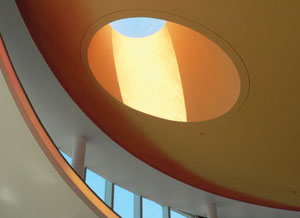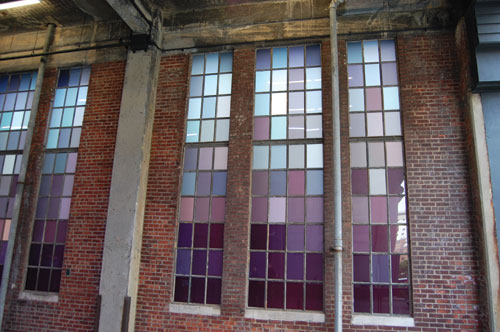Innovations in Color and Texture
While texture is clearly an artistic element of building design, it is hard to quantify. According to the National Institute of Standards and Technology (NIST), there are no standard definitions of architectural-scale texture. Some standards, such as ANSI/ASME B46.1, measure texture at a very small or microscopic scale for surfaces of mechanical systems or industrial machinery. NIST contrasts texture described as roughness, created by closely spaced peaks and valleys on a surface, as opposed to waviness, which is caused by more widely spaced irregularities. The term lay expresses the dominant direction of pattern on the surface. Topography expresses the spatial structure of the peaks and valleys on the surface, while surface finish is a catchall encompassing texture, flaws, the materials themselves and any applied coatings.
A given material surface has an inherent lay, topography and surface finish. Other architectural finishes, such as plasters, are manipulated to achieve a finish that suits the project needs. "Color is design-specific, or specific to a given region or country," says Tweedy, whose company specializes in plasters. "Some colors and textures are suited to specific parts of the world." The smooth, polished plaster walls descend from the Marmorino stucco used extensively in northern Italy during the Renaissance, often as a background for ornate frescoes. Today, high-gloss, polished finishes similar to stucco lustro Veneziano are popular in Asia and in many local markets such as Las Vegas casinos, while international design is often dominated by textured surfaces.
A deep library of descriptive terms helps communicate architectural texture; pitted walls have a grainy appearance, for example, while a dragged surface has a distinct directional lay. Some finishes emulate a different material, says Tweedy, such as travertine marble or a modern urban concrete finish—complete with shuttering marks.
Thanks to recent advances in manufacturing and fabrication, texture is appearing even on surfaces not generally considered for appreciable shape or grain. In fact, these can be applied to not only opaque materials, but also plastics, metals and glass. "The challenge we have with smooth surfaces is giving them scale, but a simple irregular pattern can give the surface life," says SmithGroup's Shockey. "For example, a dimpled stone or random dotted frit on glass."
Light-Permeable Color and Texture
Colored glass is produced by adding a metal oxide or sulfide to glass material while it is molten (see Table). Deep blues from cobalt or copper, red glasses made with traces of gold or selenium oxide, and the fluorescent yellowish green of uranium oxide are familiar in both historic cathedrals and contemporary feature walls. Manganese dioxide and sodium nitrate are employed as decoloring agents—materials that neutralize the coloring impact of impurities in glass. Texture is added to glass in the rolling machine and afterward through such finishing and treatment processes as etching, fritting and enameling, among others. Art glass textures include martelé (French for "hammered") and pulegoso, Italian for bubbly, which can be made by adding gasoline or bicarbonate of soda into the glass melt.
Metals Used to Impart Color to Glass |
|
Gold Chloride |
Red |
Cobalt Oxide |
Blue-Violet |
Manganese Dioxide |
Purple |
Nickel Oxide |
Violet |
Sulfur |
Yellow-Amber |
Chromic Oxide |
Emerald Green |
Uranium Oxide |
Fluorescent Yellow, Green |
Iron Oxide |
Greens and Browns |
Selenium Oxide |
Reds |
Carbon Oxides |
Amber Brown |
Antimony Oxides |
White |
Copper compounds |
Blue, Green, Red |
Tin compounds |
White |
Lead Compounds |
Yellow |
Manganese Dioxide |
A decoloring agent |
Sodium Nitrate |
A decoloring agent |
These traditional art-glass techniques have been revived, but the technology has advanced dramatically. "Some new glass coatings have opened up some exciting new possibilities—dichroic glass is one example, says Viñoly's Wright. "Although an ancient technique it has been reintroduced on an industrial scale and offers truly dynamic effects that change with ambient lighting conditions. Combined with various glass textures, the results can be very beautiful." Some of the newer glazings are based on technology developed by NASA, with a polychromatic effect created by the interaction of light with specialized prismatic interlayers.
Rather than using colored glass, architectural solutions increasingly rely on such interlayers, films or other materials paired with clear glazing, as seen in two art-meets-architecture applications in New York City. For the new Louis Armstrong Museum, located in a residential section of Corona, Queens, across from the famed trumpeter's former home, the firm Caples-Jefferson Architects sought to create a "façade that speaks to the visitors of the contents," says principal Sara Caples, AIA, NCARB. The resulting curved glass wall, in a yellowish cast, was envisaged as a direct homage to Armstrong's famed instrument but also as a vibrant yet soothing filter for natural daylight.
"We tried many ways to have the façade glow a yellowish cast, like a brass color," says Caples. "We looked at colored films, tinted glass, and then started to experiment with custom interlayers. Finally, we found a glass product with a metal mesh interlayer, which we could request to be brass."
 |
For the renovation and expansion of the Theatre-in-the-Park in Queens, New York, the firm Caples-Jefferson Architecture highlights an inverted acoustical dome in peach, orange and red with cold cathode lighting. Photo by Nic Lehoux |
For a very different application, a grid of custom colored glass was created by artist and photographer Spencer Finch for the defunct service rail trestles of the High Line in Lower Manhattan, an elevated park more than 20 city blocks in length with gardens, seating, refreshment areas and artworks. Finch's canvas, so to speak, was a pass-through under a commercial building. The glass panels, in seemingly random soft hues, actually each represent a single pixel point from a minute-by-minute series of Finch's photographs of the Hudson River, kept in chronological order. Finch applied a custom film to each panel in the corresponding pixel's precise color, arranged in sequence of capture.
Whether an homage to a great jazz artist or an industrial riverfront, glass proves a malleable and cost-effective way to apply both color and texture.
"Glass is an amazing blank canvas to work with," remarks Shannon Meyer, IIDA, LEED AP, director of interior design for KSQ Architects, Tulsa. "Adding texture to a glass surface aids in sun control at exterior facades and can create varying levels of privacy in interiors. Window films offer unending possibilities when it comes to color, texture and pattern. We've had great success combining multiple patterns and opacities in custom installations. The films add a level of detail and graphic pattern language to interior spaces." Novel products include a safety glass product with mirrored backing on both sides of the pane, creating two different aesthetic effects, one for each side of the glass. For interior uses, the glass product can be further modified by etching, rolling or coloring the mirror backing, creating subtle grains and hues that seem to change dramatically depending on the observer's viewing position.
"Manufacturers are redefining glass with their dimensional and sculpted products, some of which are also suitable for exterior purposes," says Lee H. Skolnick's Pang. Etched glass, for instance, is popular for decorative interior applications but often lacks the safety and insulating features for use as fenestration. Approaching the problem from an architectural viewpoint offers other solutions, says Pang. For instance, a "sculpted window" approach elevates artistic expression and offers the chance to integrate branded or decorative shapes. This dimensional glazing includes kiln-formed, heat-molded or cast glass, typically reserved for interior applications and even suitable as flooring.
 |
An artist's glass installation under a building along the High Line, an elevated park in Manhattan's Chelsea neighborhood, employs custom films laminated on glass to pick up colors associated with various light conditions over the nearby Hudson River. Photo by Andrew Russeth |









